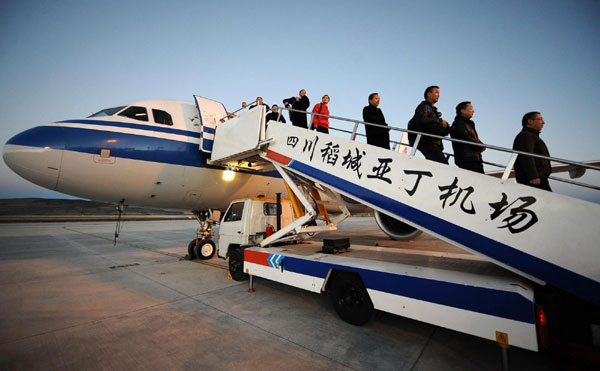Click here to view the Original Image Size China has begun flight operations at the world's highest civilian airport in a bid to boost tourism and tighten political control over the country's restive west.
Click here to view the Original Image Size
At an elevation of 4,411 meters (14,472 feet) above sea level, Daocheng Yading Airport replaces the previous champion, Bangda Airport in the Tibet Autonomous Region, which sits at 4,334 meters (14,219 feet).
Click here to view the Original Image Size Aircraft engines produce less thrust at such elevations because of the much thinner air, calling for longer runways. The one at Daocheng Yading is 4,200 meters (13,780 feet) long, just 242 meters (794 feet) shorter than the longest runway at New York's John F. Kennedy International Airport.
Click here to view the Original Image Size Passengers are also warned of light-headedness and other symptoms of altitude sickness on arrival.
State media Tuesday said flights from the new airport that began Monday will slash travel time from scenic Daocheng Yading to Sichuan's provincial capital of Chengdu from two days by bus to just 65 minutes. Other routes are to begin by the end of the month, the reports said.
Click here to view the Original Image Size The region is a gateway to Tibet, one that Beijing has sought to promote for tourism as way of tamping down dissent among the native Tibetan population and stabilizing the area through economic development.
Beijing has peppered the region with airports that see little business and spent $3.68 billion building the world's highest rail line over permafrost to Tibet's capital, Lhasa.
Daocheng Yading is a scenic area rechristened "Shangri-la" over a decade ago in the hopes that tourists would be drawn by the reference to the mythical Himalayan land described in James Hilton's 1933 novel.
Click here to view the Original Image Size However, the surrounding Garzi Tibetan Autonomous Prefecture has also been a hotbed of political unrest, including numerous self-immolations seen as protests against Chinese rule.
Click here to view the Original Image Size
The shortened travel time will make it far easier to send troops to the region in the event of major unrest, as last occurred across traditionally Tibetan parts of Sichuan in 2008.







Comments
Post a Comment